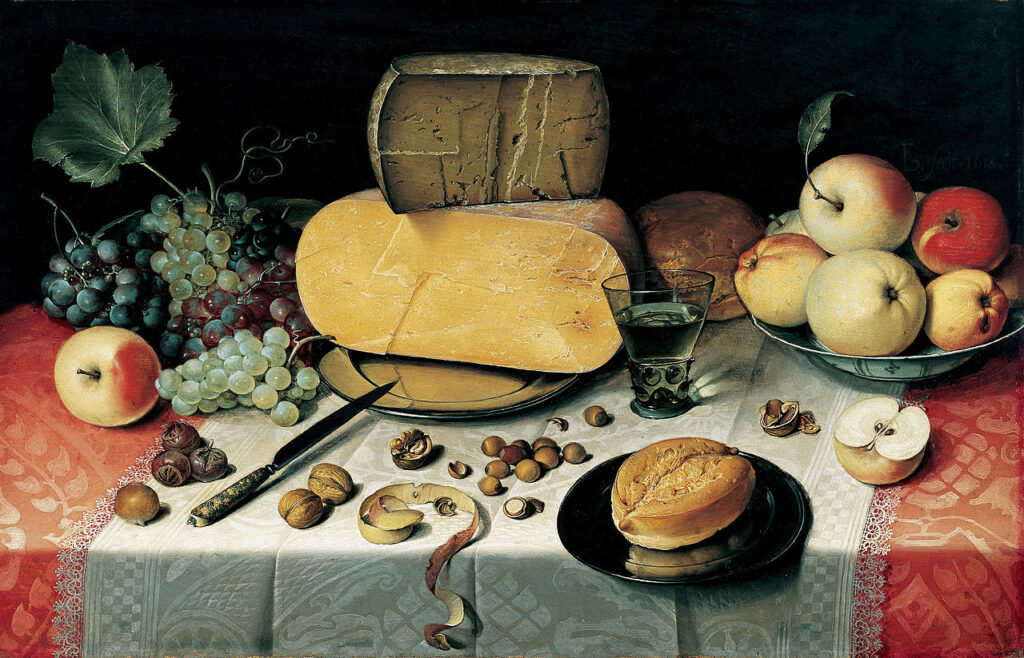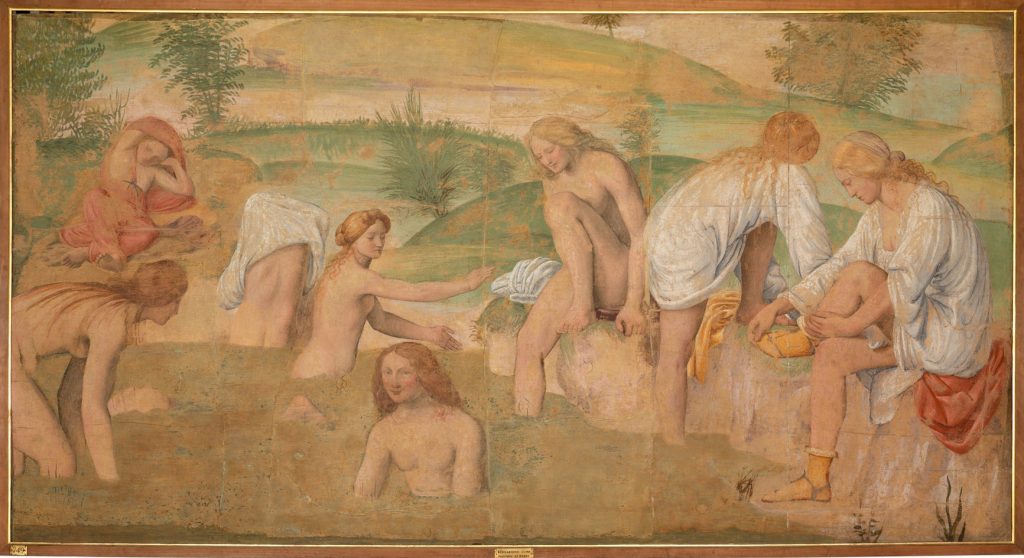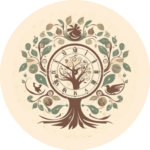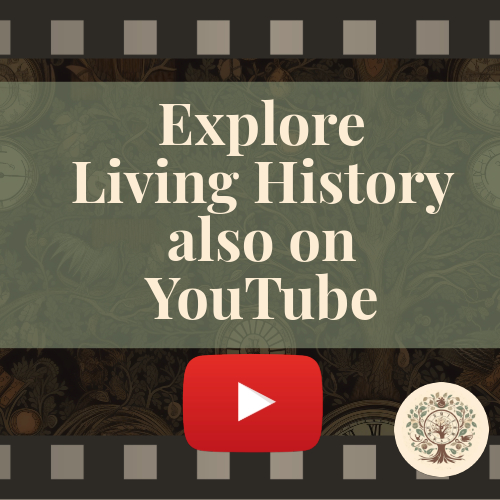When I was growing up, my grandmother told me to avoid cold showers if I was having my period. I was also not supposed to leave the house with my hair wet unless it was summer. When we travelled to the mountains, my other grandmother would ‘fill her lungs with forest air’. She claimed to feel instantly healthier. I’m sure we all heard similar things, even if the origin of this advice is often forgotten. But much of it comes from thousands of years ago, from Greco-Roman medicine. Let’s talk about preventive medicine and especially the six non-natural things, or the non-naturals. This is a key concept if you’re interested in the history of medicine, and one which I end up using in lots of videos and articles. So, I thought it might be helpful to go a bit deeper into this idea, and just how crucial it was to how people thought about the human body – and how to keep it healthy. Hopefully, a lot of weird-sounding advice will make much more sense by the end of this article!
What were the ‘Non-Naturals’?
Let’s go back to Greco-Roman medicine. In antiquity, health was understood through a holistic framework. The body itself was made of natural things (the elements, humours, faculties, and spirits), but the body was also subject to the ‘non-natural things’, things which affected bodily health. If balance was lacking, things ‘against nature’ – illnesses – could threaten the body. So, the ‘non-naturals’ weren’t ‘unnatural things’, but specific things external to the body, (res non naturales). These things had a big influence on the body’s humours (black bile, yellow bile, phlegm, and blood), whose balance determined someone’s health. So, if you didn’t pay attention to these non-natural things, the body’s natural, healthy state could turn to the contra-natural state of illness, in no small part because of humoral imbalance.


By regulating the non-naturals, on the other hand, you could protect the body in advance. For instance, you could prevent seasonal illnesses by adapting your diet. I’ll explain each of these non-naturals in a minute, but let me just give you some context. So, in the Hippocratic tradition, this kind of preventive medicine relied heavily on the balance between exercise and nourishment. By Galen’s time, the number of factors you should consider to remain healthy had expanded, and Galen’s followers coined the expression ‘non-natural things’ to describe them. During the medieval period, these texts were translated and expanded on by Arabic physicians, especially Ibn Sina. In his work The Canon of Medicine, the most popular medical textbook well into the Renaissance, he maintained the classical idea that prevention and treatment were equally important in medicine. Treatment and prevention were two sides of the same coin: medicine was not only a healing art but the art of preserving health. So, the fields of hygiene and dietetics (roughly what we would call ‘preventive medicine’) were further developed during this period by physicians such as Aldobrandino da Siena and Arnau de Villanova, relying heavily on the classical tradition.


So, by the Renaissance, prevention was a key branch of medicine, and doctors’ advice centred around managing the non-naturals. Physicians who routinely prescribed remedies for their patients, rather than creating a bespoke regimen for them, were criticised by their peers. George Cheyne, whose writing style is just irresistible, described these less-than-competent practitioners as people who ‘never dare order a Regimen, and who are continually cramming their patients with nauseous and loathsome Potions, Pills and Bolus’s, Electuaries, Powders and Juleps.’. For Cheyne, prevention was key.
Plus, although doctors had been writing regimens of health for centuries (guides on healthy living, essentially), these books were now available in print, making them available to many more readers than before. People worried about getting a good night’s sleep, which kind of exercise best suited their bodies, how to keep their hair clean, and whether the air around them was beneficial to their health. And not just wealthy people, although of course, they had more resources, more time and money, which determined how much agency and choice they could have over their health – for instance, deciding on the ideal place to build a house. But even tradesmen and craftsmen could have access to this kind of advice. Remember that this was a time in which much was unknown about how the body and diseases worked, so, seeking advice about managing the non-naturals would have given laypeople a sense of control over their lives. This led to a widespread culture of prevention during the Renaissance, and the non-naturals, as a flexible framework for thinking about health and the body, acted as the bedrock upon which preventive medicine was developed.
So, if we think of a 16th-century person interested in buying a book about domestic medicine at their local fair, they usually could choose between two big groups: recipe books, full of remedies for common ailments, and regimens for a healthy life. The first group was usually about treating a specific problem, while the latter was about preventing illness in the first place. As I mentioned, a regimen was a collection of guidelines on how to remain healthy; they were addressed to a general readership, and they were full of advice about the non-naturals. In fact, these books remained popular for centuries, and they were still structured around the non-naturals well into the 18th century.


So, how would, say, a 16th-century person go about preventing illness? Well, they needed to be mindful of the six ‘non-natural’ things which determined health: food/drink, exercise/rest, air, sleep, evacuation/repletion, and strong emotions. There were no universal rules; everything had to be adapted to the person’s individual bodily constitution. And doctors didn’t always agree; I mean, one of them, Ippolito Guarinoni, even suggested that there should be a seventh non-natural: God. But let’s stick with the six less-controversial ones for today. I won’t go into too much detail here, but let me know in the comments if you have any questions or whether you’d like to learn more about any of these topics.
1. Nourishment (Food and Drink)
Today, whether you’re browsing books at the library or watching a TikTok, most dietary advice has to do with weight management or maybe preventing heart disease or dealing with diabetes. Renaissance physicians, on the other hand, wrote of how rational thought could be improved through diet, how fevers could be avoided, how infertility could be treated, and how humoral balance could be achieved and maintained. In the same way that people had individual constitutions, so did foods and beverages, which could be hot, cold, dry, or wet. These qualities should be taken into consideration when choosing and preparing foods and drinks. For instance, wine was believed to ‘heat’ the body, which is why it should be drunk in moderation, especially by those who had a choleric or sanguine temperament. Those who were pregnant or nursing should water their wine down to diminish its heat. It was believed that the stomach was responsible for concocting food before it would be distributed in the body by the blood. Because they influenced the digestive process, some foods such as raw vegetables were believed to prepare the stomach for a meal, while others would be more suited to ‘closing’ the stomach afterwards. That’s why people would eat cheese at the end of a meal – and many still do. And, if you would like to explore this in more detail, I suggest checking out another text I made on food and the order in which people ate at the time (there’s also the video version here).



2. Air
You may have heard of the miasma theory before; the idea that disease was caused by a miasma – bad or corrupted air. Many conditions, from the plague to cholera, have been explained through this framework. This was a highly influential idea, from antiquity until the 19th century and the development of germ theory. But even if you’re not specifically thinking of disease, the nature of the air was considered important for maintaining health, too. The air was a common cause of concern for 16th-century people. Was it cold or hot? Humid or dry? See how we come back to these qualities and their relationship with the humoral theory. Depending on the person’s constitution, age, gender, and the season of the year, the air could have different effects. For Ibn Sina, the air should be temperate: light, bright, moving gently, and smelling sweet. People were advised to purify the air with fire and scented herbs. And just a quick tangent here: the plague doctor, and that famous mask, are a great example of that. By breathing through the mask, whose long beak was filled with special herbs, physicians were believed to be protected from the corrupt air around those who were ill. Plus, doctors often prescribed a change of location to their patients, in the hope that illness could be cured in a place where the air was different. This was particularly common in the 19th century. The brain was thought to be very vulnerable to air – have you ever noticed when you visit a museum how people in the past always seem to be wearing headwear or hats in the paintings? Besides fashion, the concern with air directly influenced fashion. Not to mention architecture. An ideal Italian villa in the Renaissance would have been high up to enjoy the breeze and the sun, but not too exposed to inclement winds. And don’t even think about building your dream house next to a sewer – but who would, if given the choice? Many of these ideas still survive today. In Italy, people talk about a colpo d’aria – literally a ‘hit of air’ – as something that can cause coughs, muscular pain and whatnot.


3. Motion (Exercise and Rest)
I recently made a video on Girolamo Mercuriale, a Renaissance physician who was a big advocate for exercise, so go check that out if you’d like to learn more (and here’s a text version if you prefer). But to sum it up, exercise was believed to improve bodily functions: for instance, it heated the body, promoting digestion. It opened the pores, allowing waste to leave the body through sweat. For Galen, exercise should be vigorous, accompanied by accelerated breathing. But later physicians, like Mercuriale, cautioned people to be moderate and to adapt exercise to their individual needs. They could be active (such as walking) or passive (such as being transported in a carriage). Those who could not partake in strenuous activities could resort to baths or massages, which would attain similar health results. And it does sound much nicer, to be fair. In any case, exercise should be followed by rest, which was equally important for the body to recover.


4. Waking and Sleeping
Regimens of health directed people about how, for how long, and when one should sleep to maximise their health. The main concern was with digestion, as it was believed that sleep was caused by the vapours rising from the food in the stomach to the brain as it was digested. Daytime naps were not advised, as they wouldn’t be long enough for digestion to be complete. Plus, they could cause laziness. As wealthier parts of the population started to nap in the 17th century, it was thought that a wooden chair would be ideal: not too comfortable was the goal. Sleeping on your back was not advised, as these vapours could get blocked in the brain. Elevating your head and sleeping on one side would be better for digestion as well as protecting the brain. Ideally, you should switch sides every couple of hours… But I’m not sure how often people followed this advice after a rich mutton stew and wine! In any case, though, you should be mindful of how you slept, and advice would change according to the seasons and your age, and whether you were pregnant. As always, though, by the time you’re 8 or 9 months pregnant, you should be glad if you can manage to sleep at all, really.


5. Evacuation/Repletion
Stay with me, this is not as gross as it may seem. We’re not only talking about urine and faeces here – there are many other kinds of ‘excrements’ in the way people thought about the body in this period. So, within the humoral understanding of the body, corrupt or excessive humours often needed to be purged, and impurities, expelled. The regular purging of the body was seen as essential to maintaining one’s health: bloodletting, inducing vomit, provoking sweat, as well as stimulating retained menstruation were all important parts of preventing illness – and not just treatments for it. Even a person’s sex life would fall under this category, as fluids were evacuated from the body. And that was important, as excessive, superfluous fluids might cause blockages if not removed from the body. My grandmother (the paternal one this time) believed we should brush our hair vigorously, especially before bed. That would make sense to our hypothetical 16th-century person buying a book at the local fair. Combs were essential in removing the ‘excrements of the head’, and combing one’s hair was not just about vanity, but about preventing brain issues by making sure that what needed to be expelled from the body didn’t cause any obstructions. If you’re interested in bodily hygiene, I suggest checking out my video on that for more details (and here is the text version on Hygiene). But just think of barbers and their connection to medicine (especially barber surgeons). They took care of people’s hair, beards, nails, ears, teeth, and skin, mainly for hygienic purposes. They even had separate comb sets for beards and hair – you wouldn’t want any cross-contamination with your head’s excrements!



6. Passions (Emotional Life)
To round up our set on non-naturals, and thinking of lifestyle and well-being, to use contemporary terms, we need to talk about the passions, which the Greeks called the ‘accidents of the soul’; what we might think of as mental health today. A person’s emotional life was thought to greatly affect their health. This was mainly because these fluctuations influenced the heart, responsible for heating the body through the blood. Emotions would have a direct effect on the body’s temperature and, as we have seen, the balance between hot/cold and wet/dry was central in the humoral understanding of the body. So, physicians advised their patients to be careful with the passions most likely to disturb their humoral balance: someone of a choleric temperament should be careful with anger or hate, as they would make the body drier and hotter. On the other hand, another patient might benefit from periodic outbursts of anger, if they needed to release excessive heat. Doctors advised their patients on managing their emotional states; this psychosomatic approach to health was, of course, very different to how conceptualise the relationship between the body and the mind today, but there’s no arguing that there is a connection between mental and bodily health. So, emotions, especially strong emotions, were a crucial part of the non-naturals. As is often the case for Renaissance writers, the key was moderation, as a sudden emotional change could trigger illness or even death. Remember all the stories of people dying from a broken heart in literature? The non-naturals are behind that idea.

Final Thoughts
The non-naturals are a big topic, in the same way that the humoral theory is, and much more could be said about each of them. For centuries, environment and lifestyle were crucial to how physicians and patients thought about health. I mean, phlebotomy, or blood-letting, was still practised until well into the 19th century, in many cases as a preventative measure rather than a treatment. Of course, all that changed with the ‘bacteriological revolution’ of the late 19th century. In any case, understandings of how the ‘non-naturals’ should be managed varied greatly across time and space, and this article can only hope to give the briefest introduction to this subject. But I hope that I managed to show the logic behind this way of thinking about health and what we would today call ‘lifestyle’ and how it affects the body. My grandmothers might have been a bit off with their advice. But they were the heirs to a long tradition of trying to be as healthy as possible and to live a long life – and isn’t that what we all want?
References:
Avicenna, A Treatise on the Canon of Medicine of Avicenna (London: Luzat, 1930).
Castore Durante, Il Tesoro della Sanità (Venice: Andrea Muschio, 1586).
Rodrigo Fonseca, Del Conservare la Sanità (Florence: Semartelli, 1603).
Galen, De sanitate tuenda: A Translation of Galen’s Hygiene (Springfield: Thomas, 1951).
Hippocrates, Airs, Waters, Places (London: W. Heinemann, 1923).
Bartolomeo Paschetti, Del Conservar la Sanità (Genoa: Giuseppe Pavoni, 1602).
Regimen sanitatis salernitatem, translated bt John Harrington (1608).
Further Reading:
Sandra Cavallo and Tessa Storey, Healthy Living in Late Renaissance Italy (Oxford: Oxford University Press, 2013).
Lawrence Conrad, Michael Neve, Vivian Nutton, Roy Porter, Andrew Wear, The Western Medical Tradition: 800 BC to AD 1800 (1995).
David Gentilcore, Food and Health in Early Modern Europe: Diet, Medicine and Society (1450-1800) (London: Bloomsbury, 2016).
Sasha Handley, Sleep in Early Modern England (New Haven, CT: Yale University Press, 2016).
James Kennaway and Rina Knoeff (eds.), Lifestyle and Medicine in the Enlightenment: The Six Non-Naturals in the Long Eighteenth Century (2020).






